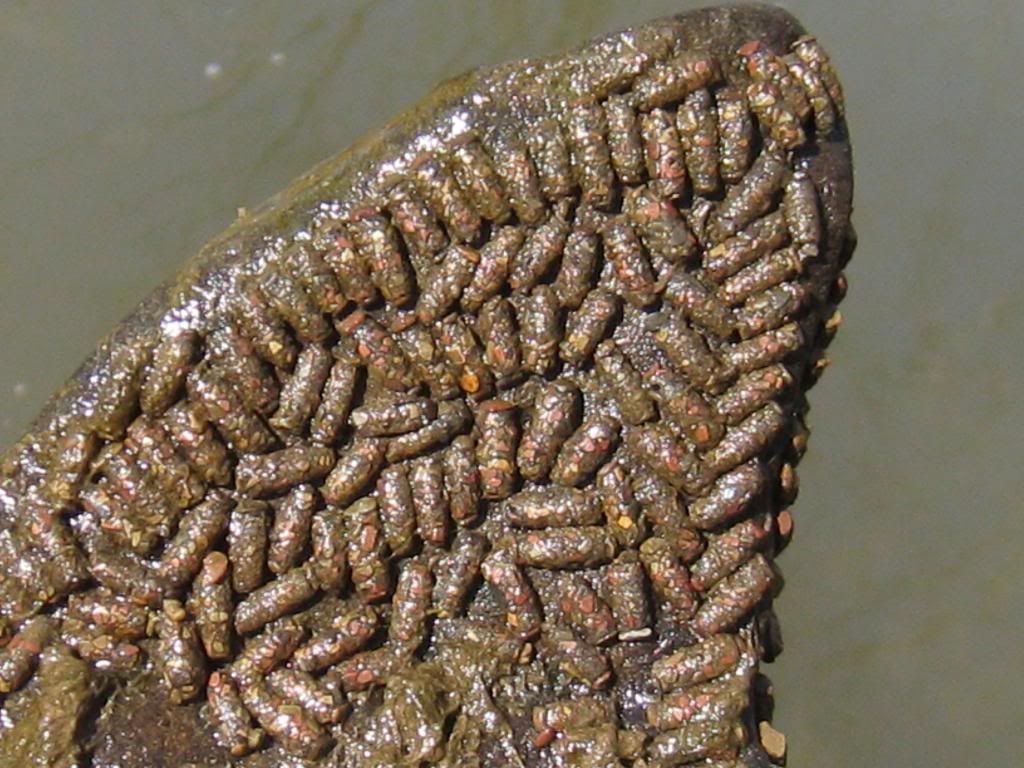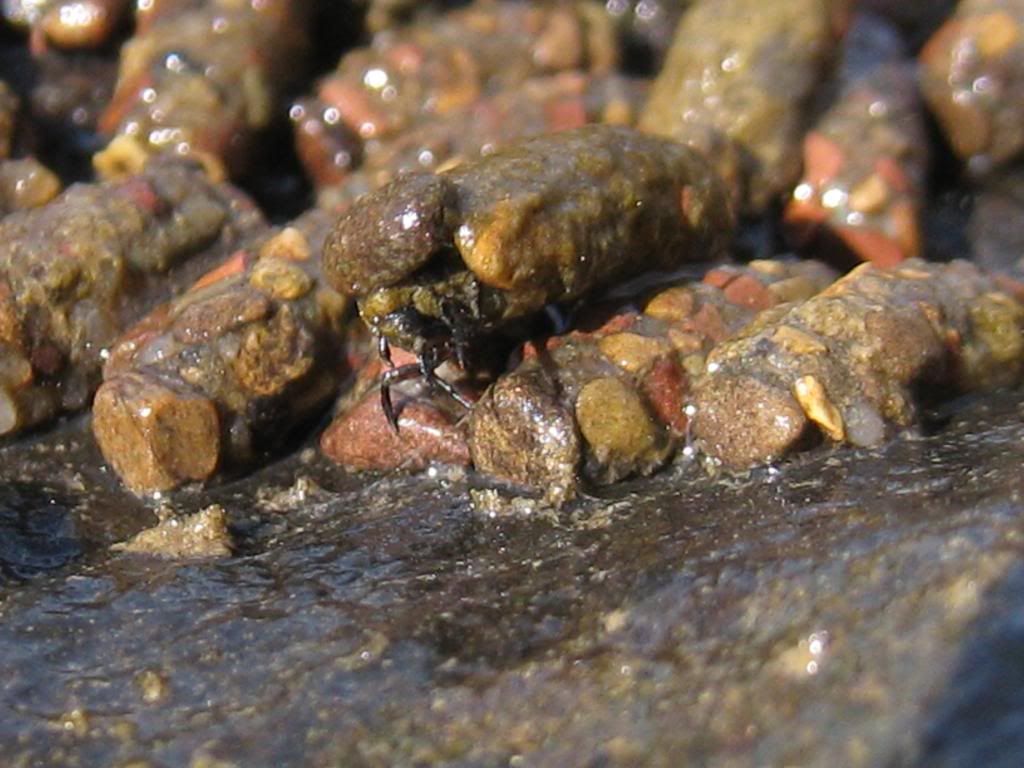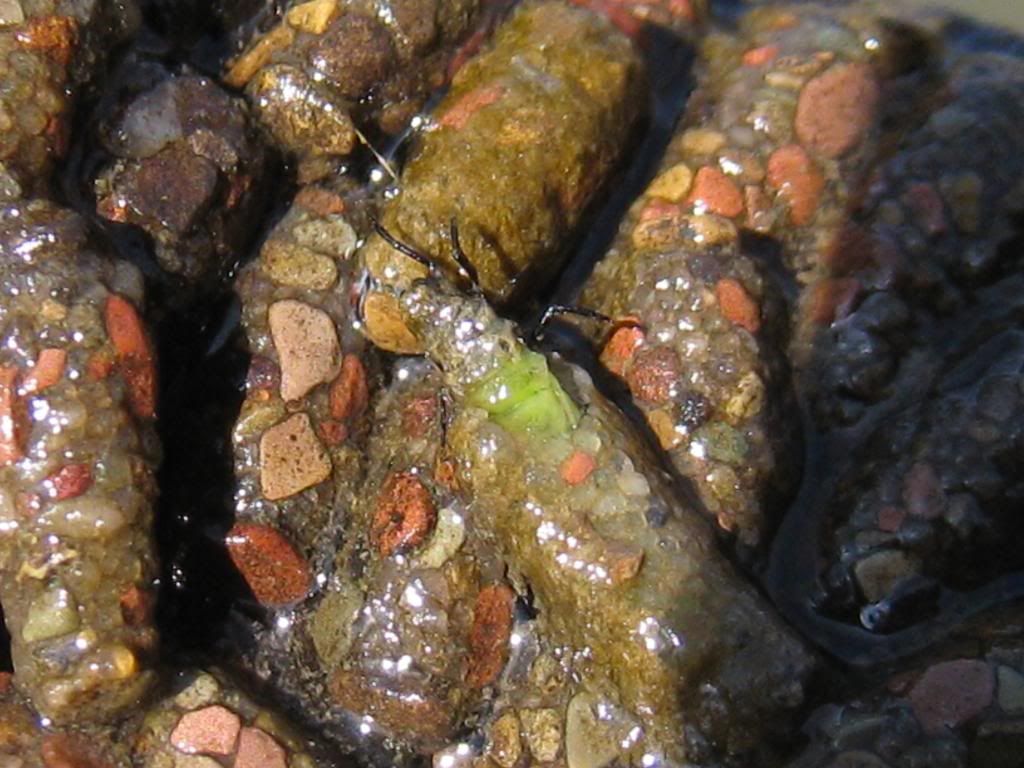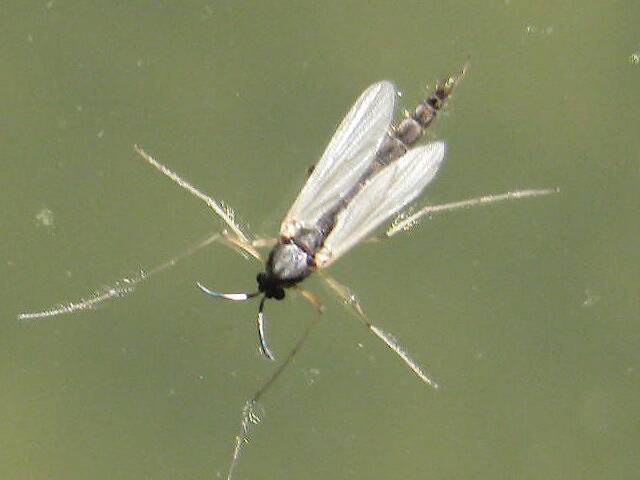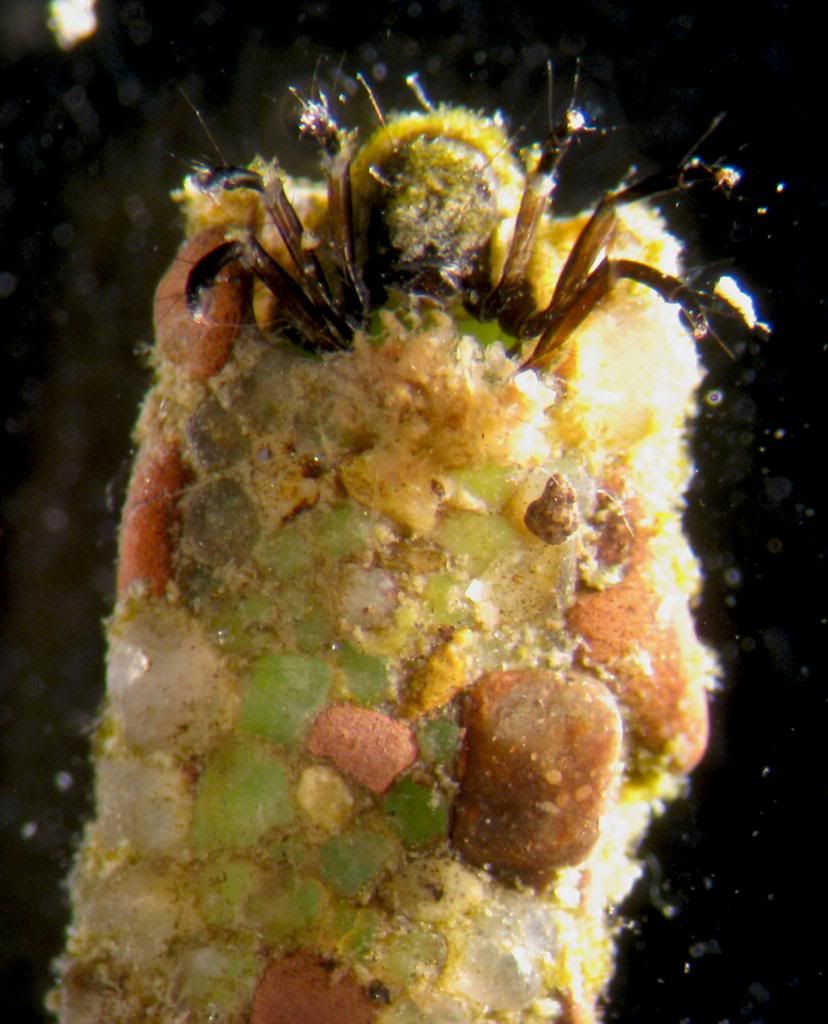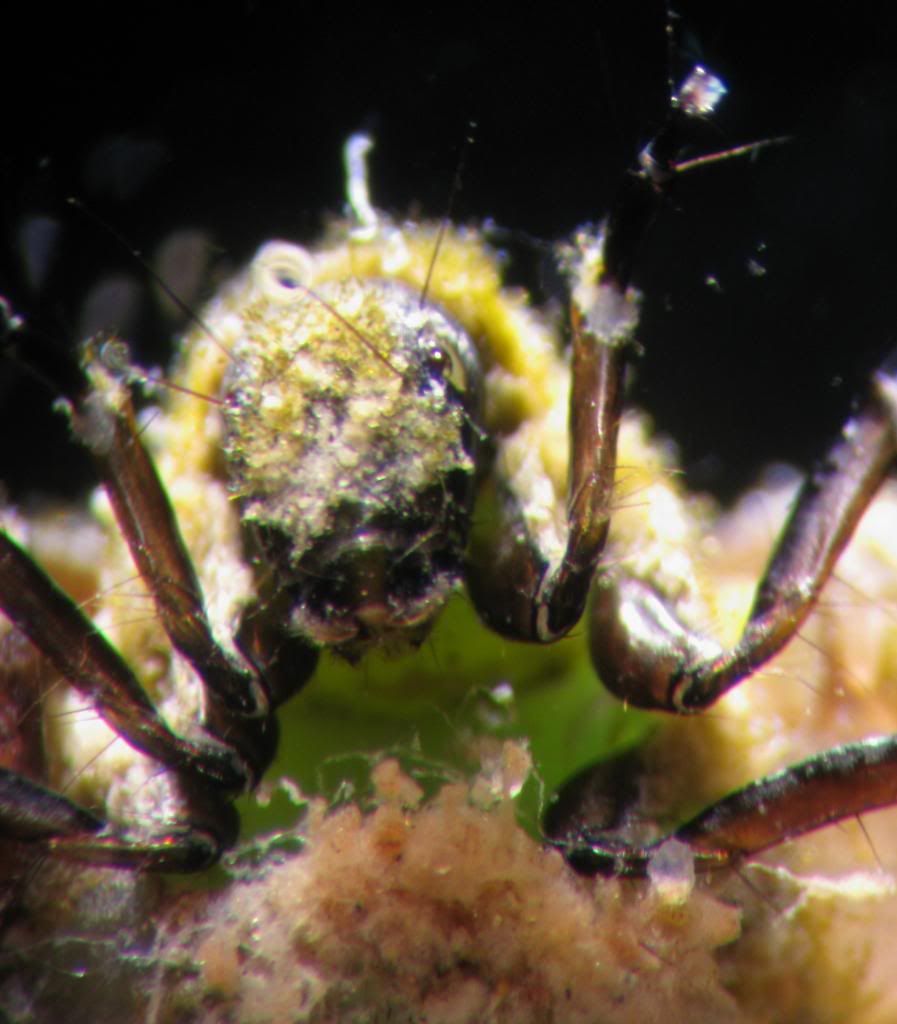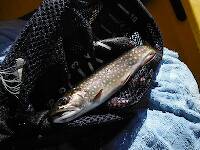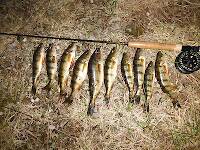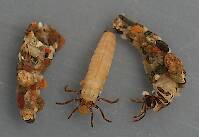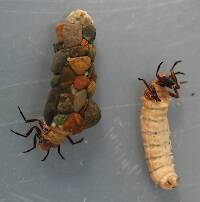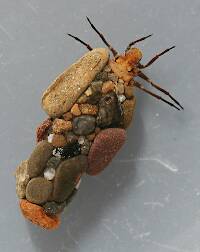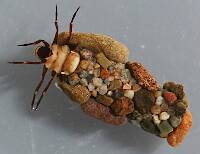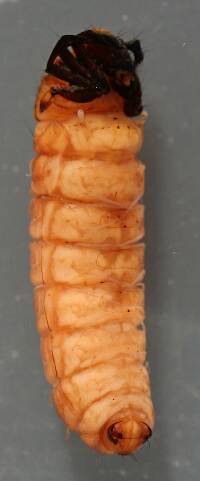
Hex Mayflies
Hexagenia limbata
The famous nocturnal Hex hatch of the Midwest (and a few other lucky locations) stirs to the surface mythically large brown trout that only touch streamers for the rest of the year.
Featured on the forum

This one seems to lead to Couplet 35 of the Key to Genera of Perlodidae Nymphs and the genus Isoperla, but I'm skeptical that's correct based on the general look. I need to get it under the microscope to review several choices in the key, and it'll probably end up a different Perlodidae.

Troutnut is a project started in 2003 by salmonid ecologist Jason "Troutnut" Neuswanger to help anglers and
fly tyers unabashedly embrace the entomological side of the sport. Learn more about Troutnut or
support the project for an enhanced experience here.
Entoman on Mar 5, 2013March 5th, 2013, 10:16 am EST
Man, that's a healthy population! Psilotreta (Dark Blue Sedge)?
"It's not that I find fishing so important, it's just that I find all other endeavors of Man equally unimportant... And not nearly as much fun!" Robert Traver, Anatomy of a Fisherman
Falsifly on Mar 5, 2013March 5th, 2013, 10:22 am EST
Any thoughts on what appears to be a somewhat organized pattern?
Falsifly
When asked what I just caught that monster on I showed him. He put on his magnifiers and said, "I can't believe they can see that."
When asked what I just caught that monster on I showed him. He put on his magnifiers and said, "I can't believe they can see that."
Entoman on Mar 5, 2013March 5th, 2013, 10:46 am EST
Each specimen optimizing flow velocity creating a group pattern that tracks the laminar flow like smoke in a wind tunnel?
"It's not that I find fishing so important, it's just that I find all other endeavors of Man equally unimportant... And not nearly as much fun!" Robert Traver, Anatomy of a Fisherman
Falsifly on Mar 5, 2013March 5th, 2013, 11:35 am EST
Each specimen optimizing flow velocity creating a group pattern that tracks the laminar flow like smoke in a wind tunnel?
I don’t know Kurt. I can only associate that with vortex generators placed on the cambered surface of high performance airfoils to promote laminar flow, reducing drag and delaying airflow separation in stall progression. Would there be an advantage in streamlining the flow of nutrients to the larva? I’m not familiar with how they feed.
Falsifly
When asked what I just caught that monster on I showed him. He put on his magnifiers and said, "I can't believe they can see that."
When asked what I just caught that monster on I showed him. He put on his magnifiers and said, "I can't believe they can see that."
Sayfu
Posts: 560
Posts: 560
Sayfu on Mar 5, 2013March 5th, 2013, 11:43 am EST
As a real novice at aquatic bug ID'n my guess would have been dicosmoecis given the bigger rock inclusions. But I also have never seen them that tightly grouped.
Entoman on Mar 5, 2013March 5th, 2013, 12:17 pm EST
Alan - They are grazers not filter feeders, so their concern for proper flows would have more to do with oxygen delivery. They would be more random and less concentrated if feeding so I assume the behavior in the photo is related to orientation for pupation? Creno will know.
Sayfu - Yes, Dicosmoecus (October Caddis) was my first impression as well but that's just our western bias kicking in.:) PA doesn't have them. These cases are much smaller and wider for their length compared to our critter.
Edit: The larvae are green as well.
Sayfu - Yes, Dicosmoecus (October Caddis) was my first impression as well but that's just our western bias kicking in.:) PA doesn't have them. These cases are much smaller and wider for their length compared to our critter.
Edit: The larvae are green as well.
"It's not that I find fishing so important, it's just that I find all other endeavors of Man equally unimportant... And not nearly as much fun!" Robert Traver, Anatomy of a Fisherman
Lastchance on Mar 5, 2013March 5th, 2013, 12:31 pm EST
Each specimen optimizing flow velocity creating a group pattern that tracks the laminar flow like smoke in a wind tunnel?
Wow! I don't know what you said, but it sure sounds intelligent. I'm staying away from that laminar flow. It sounds dangerous. HA!HA!
Entoman on Mar 5, 2013March 5th, 2013, 2:48 pm EST
Wow! I don't know what you said, but it sure sounds intelligent.
I'm not sure I know either, Bruce. But it does sound good, doesn't it...:)
Perhaps I used Laminar inappropriately, Alan. I'm talking about the flow of water over the rock and each organism's attempts to adapt to the changes in it caused by the others.
"It's not that I find fishing so important, it's just that I find all other endeavors of Man equally unimportant... And not nearly as much fun!" Robert Traver, Anatomy of a Fisherman
Falsifly on Mar 5, 2013March 5th, 2013, 3:07 pm EST
I'm talking about the flow of water over the rock and each organisms attemts to adapt to the changes in it caused by the others.
Ok Kurt, now things are making a little more sense. It would have been helpful for our discussion had the rock's position, relative to the current flow direction, been known. Yes?
Falsifly
When asked what I just caught that monster on I showed him. He put on his magnifiers and said, "I can't believe they can see that."
When asked what I just caught that monster on I showed him. He put on his magnifiers and said, "I can't believe they can see that."
Entoman on Mar 5, 2013March 5th, 2013, 3:15 pm EST
Yes. I'm assuming the rock was caddis up and they were on the back side? If the caddis were under the rock (as when they are feeding and living normally), I would expect them to be much less concentrated to allow for grazing room.
"It's not that I find fishing so important, it's just that I find all other endeavors of Man equally unimportant... And not nearly as much fun!" Robert Traver, Anatomy of a Fisherman
Crepuscular on Mar 5, 2013March 5th, 2013, 3:20 pm EST
It would have been helpful for our discussion had the rock's position, relative to the current flow direction, been known. Yes?
Downstream side of the rock. There were a bunch of rocks like that and they were all positioned the same way. I'm sure that Creno can elucidate why they do that. My guess would be that since they don't need to feed, the most protected position on the substrate would be the downstream side. But like you described earlier, they would still be able to get plenty of oxygen.
Martinlf on Mar 5, 2013March 5th, 2013, 3:26 pm EST
I believe this is actually the site of a mosh pit at a caddis rave. Had Eric put his ear very close to the rock before removing it from the stream he most likely would have heard the sound of electric guitars. In a few minutes the larvae surfing would have begun.
"He spread them a yard and a half. 'And every one that got away is this big.'"
--Fred Chappell
--Fred Chappell
Falsifly on Mar 5, 2013March 5th, 2013, 3:37 pm EST
Ha, good one Louis.
Falsifly
When asked what I just caught that monster on I showed him. He put on his magnifiers and said, "I can't believe they can see that."
When asked what I just caught that monster on I showed him. He put on his magnifiers and said, "I can't believe they can see that."
Entoman on Mar 5, 2013March 5th, 2013, 3:39 pm EST
LOL!
"It's not that I find fishing so important, it's just that I find all other endeavors of Man equally unimportant... And not nearly as much fun!" Robert Traver, Anatomy of a Fisherman
Creno on Mar 5, 2013March 5th, 2013, 4:42 pm EST
a mosh pit ain't far off. They are pupal cases so they are not feeding. Just like any other bug we have no idea what they are doing - we just make up stuff about what we think they are doing. Folks think aggregate pupation is a predator avoidance mechanism. The predator has to find the right rock and when it does it is quickly sated by the mosh and the majority survive. Same rationale put forth for some schooling fish. But who knows - there sure are alot more taxa out here that don't do this and seem to get along just fine.
What I find interesting in taxa that do this is that they often pick the largest substrate around - they don't like their rock & roll. When I am collecting I always start with the large rocks/sticks/etc. That is usually where the most taxa are. What I don't understand is how they find the largest substrate around and how do they know when they have found it? Fascinating stuff.
What I find interesting in taxa that do this is that they often pick the largest substrate around - they don't like their rock & roll. When I am collecting I always start with the large rocks/sticks/etc. That is usually where the most taxa are. What I don't understand is how they find the largest substrate around and how do they know when they have found it? Fascinating stuff.
Crepuscular on Mar 6, 2013March 6th, 2013, 4:14 am EST
Feathers5
Posts: 287
Posts: 287
Feathers5 on Mar 6, 2013March 6th, 2013, 4:53 am EST
I believe this is actually the site of a mosh pit at a caddis rave. Had Eric put his ear very close to the rock before removing it from the stream he most likely would have heard the sound of electric guitars. In a few minutes the larvae surfing would have begun.
I thing they were gathering for the Harlem Shake.
Oldredbarn on Mar 6, 2013March 6th, 2013, 7:43 am EST
Location, location, location! ;)
"Even when my best efforts fail it's a satisfying challenge, and that, after all, is the essence of fly fishing." -Chauncy Lively
"Envy not the man who lives beside the river, but the man the river flows through." Joseph T Heywood
"Envy not the man who lives beside the river, but the man the river flows through." Joseph T Heywood
Entoman on Mar 6, 2013March 6th, 2013, 12:33 pm EST
I'm pretty sure these are Neophylax.
Yep, your latest photos are great and show this unmistakably. Whew... Psilotreta's repution is in tact. I didn't think they were into such unbecoming behavior as mosh pits...:)
"It's not that I find fishing so important, it's just that I find all other endeavors of Man equally unimportant... And not nearly as much fun!" Robert Traver, Anatomy of a Fisherman
Quick Reply
Related Discussions
Topic
Replies
Last Reply
7
Nov 20, 2006
by GONZO
by GONZO
14
May 5, 2016
by Martinlf
by Martinlf
1
Apr 10, 2008
by Wbranch
by Wbranch
4
Jun 16, 2011
by Troutnut
by Troutnut
8
Jun 5, 2007
by Dinerobyn
by Dinerobyn
2
Feb 6, 2017
by Crepuscular
by Crepuscular




